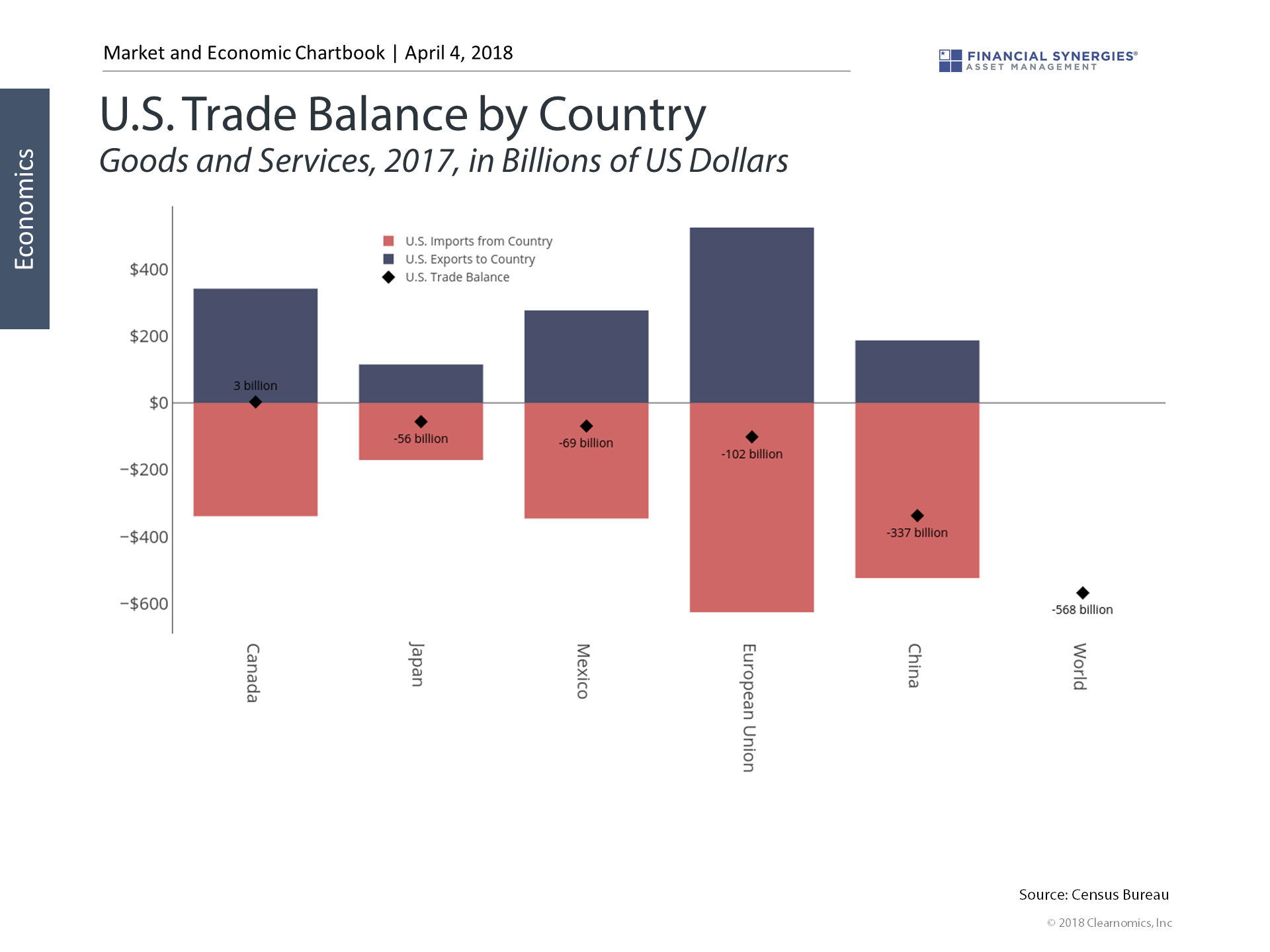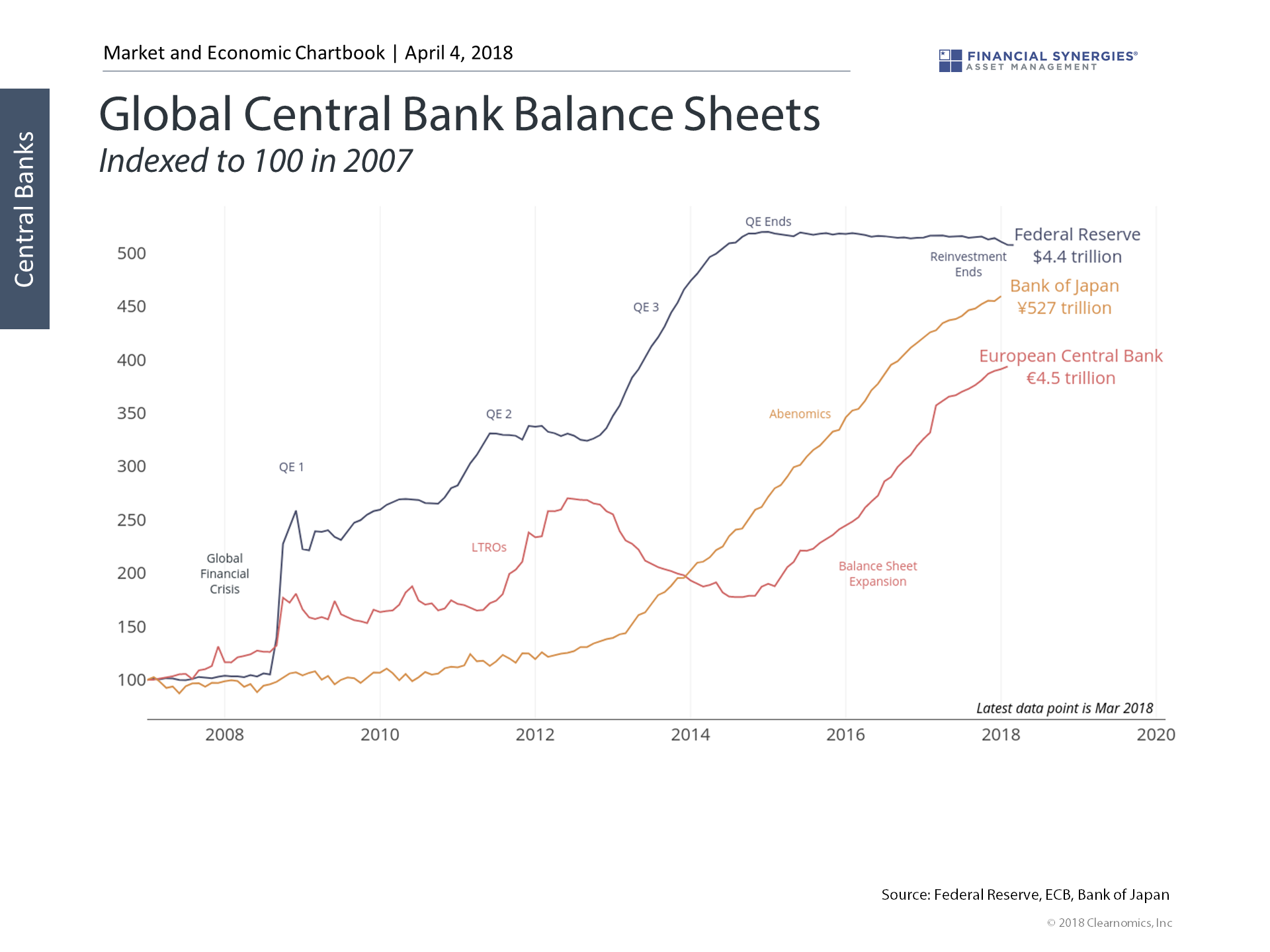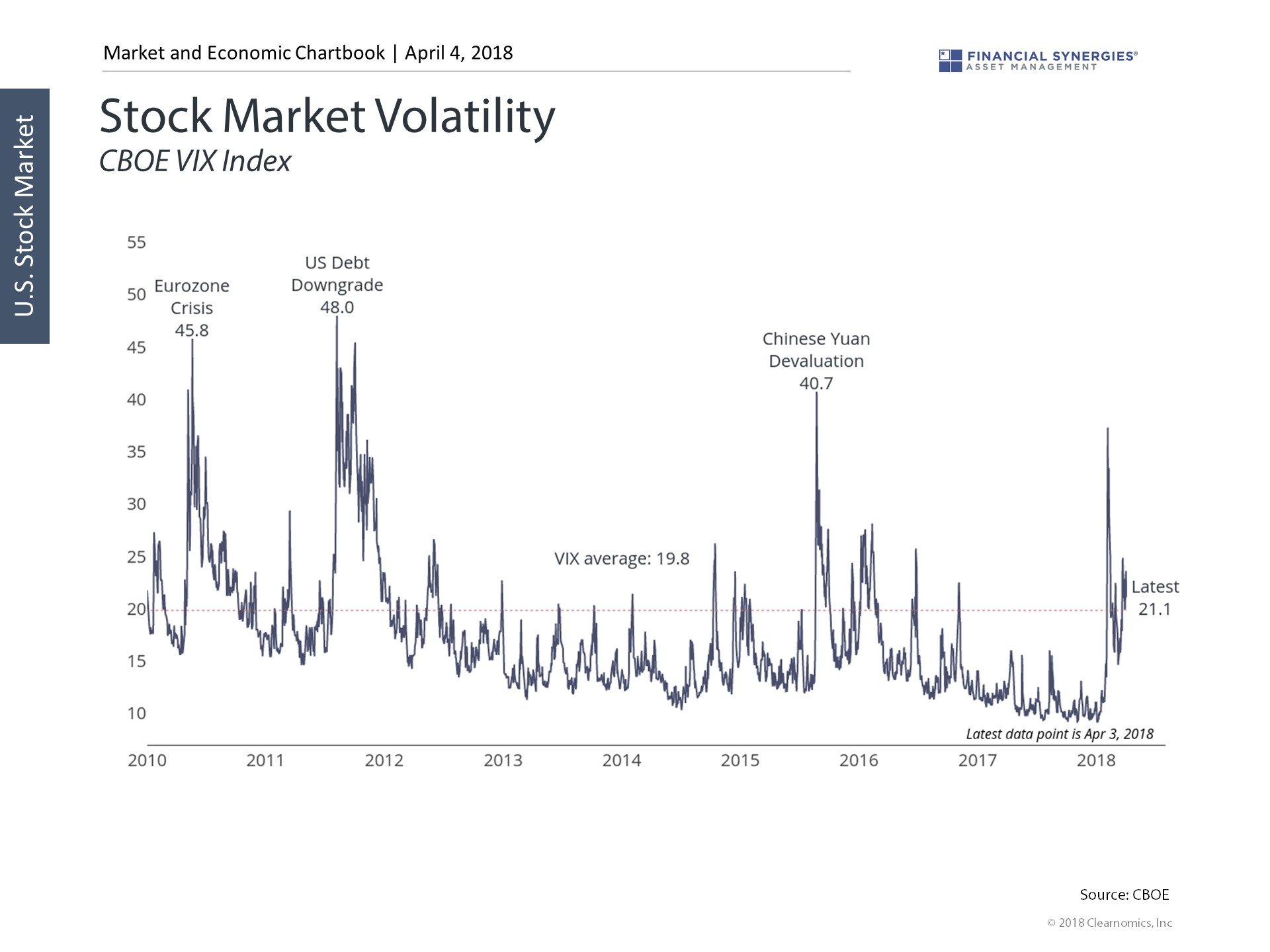In a nutshell, the 1st quarter was defined by tariffs, technology, rates, and volatility. All the while the global economic engine kept chugging, and remains fundamentally strong. The market was shot out of a cannon to start 2018, but as various pressures and perhaps an overly exuberant investing public took hold, the party came to an end in late January.
Although the market entered into a technical “correction,” the major indices managed to avoid major declines for the 1st quarter. The S&P 500 and Dow Jones declined -0.76% and -1.97% respectively. And the Nasdaq was actually in positive territory for the quarter at 2.59%, which is surprising given its tech-heavy composition. More on technology later.
Let’s break down each of the major themes of 2018 so far: Tariffs, Technology, Rates, and Volatility.
Tariffs and Trade Wars
Trade policy is a key political issue for the Trump administration. Last year, the U.S. ran a trade deficit of over half a trillion dollars. Our trade with China alone added $337 billion to this deficit. This has naturally led to concerns that we are being taken advantage of, resulting in trade tariffs to support those industries that have been disrupted by globalization. Whether you agree with this or not, there are workers that have been left behind, fueling age-old political and populist forces.
Many U.S. workers have faced tremendous difficulty as technology has made many jobs obsolete and globalization has moved jobs overseas. The administration’s goal of protecting domestic industries taps into this unrest.
China and Mexico are easy scapegoats for the loss of U.S. industrial jobs over the past several decades. However, from an economic perspective, these are symptoms of the unstoppable forces of technology and globalization. The joke, attributed to Warren Bennis, is that “the factory of the future will have only two employees, a man and a dog. The man will be there to feed the dog. The dog will be there to keep the man from touching the equipment.” Promoting American industries may temporarily stanch the flow, but can’t reverse it. It appears that most industries oppose tariffs since globalization has brought more benefits than costs.
U.S. Trade Balance by Country

The chart above shows the U.S. trade balance across major trading partners. In 2017, the total U.S. trade deficit reached $568 billion. Countries such as China and Mexico are easy political targets due to our sizable imbalances with these trading partners. However, the U.S. ran significant trade deficits with our other allies as well, including the European Union and Japan.
The potential for a trade war with countries such as China is worrying markets. This is a legitimate concern since free trade disproportionately benefits U.S. consumers and companies, even if some industries do lose out. The best hope for global trade is that cooler heads prevail, allowing the U.S. to reach trade agreements with its major partners.
Whether trade deficits are inherently bad is a matter of academic debate. In theory, by importing more than we export, we are “borrowing” from the rest of the world. The IOU’s we issue to do this are U.S. dollars, which in theory should lose value as we “borrow” more. Thus, the question is whether we gain more than we lose via trade. The fact that most consumers and industries benefit from lower cost goods and services is one reason the trade deficit is unlikely to be closed by policymakers.
Technology
Investors were also worried about technology stocks in the first quarter, driven by a number of stock-specific concerns. This has become an important issue due to the outsized performance of the sector and the growing market caps of its largest players (often referred to as the FANG stocks). In fact, there have been many periods over this cycle when FANG stocks drove overall market performance.

As shown in the chart above, despite recent troubles, the technology sector has still gained over 24% over the past 12 months. Additionally, the goal of long-term investors is to diversify across not just asset classes, but sectors as well. Not only have many other sectors outperformed over this period, but the earnings outlooks for ten of the eleven sectors is still positive. Thus, while the technology sector may be impacting the broader market today, properly diversified investors should be less concerned.
Rates
The Fed raised the federal funds rate in March in response to a healthy U.S. economy. In its updated economic projections, it emphasized that unemployment can fall much lower than in past cycles without stoking inflation. This suggests that while we may see four interest rate hikes this year, the Fed is not yet concerned about having to tighten too quickly.
 From a global perspective, central banks have entered a new phase. The Fed has been reducing stimulus and tightening policy since late 2013. Other central banks are now beginning to follow suit by reducing their asset purchases, paving the way for eventual monetary tightening.
From a global perspective, central banks have entered a new phase. The Fed has been reducing stimulus and tightening policy since late 2013. Other central banks are now beginning to follow suit by reducing their asset purchases, paving the way for eventual monetary tightening.
At the moment, they are doing so because economic growth is healthy. Thus, this is still good news for global stocks.
Volatility
And of course, all these issues have led to an increase in volatility. Volatility rose in the first quarter after an extremely quiet 2017. The VIX index of volatility reached 37, its highest level since 2015. So far in 2018, the worst market pullback has been 10%.
 Still, this is below the historical average of 13.5% since World War II. Despite these market pullbacks, most years end in positive territory, averaging 9% gains – this is why stocks have historically been great long-run investments, despite short-term volatility.
Still, this is below the historical average of 13.5% since World War II. Despite these market pullbacks, most years end in positive territory, averaging 9% gains – this is why stocks have historically been great long-run investments, despite short-term volatility.
Unfortunately, volatility is the norm and can only be managed by investing over long time horizons and via diversification, not by trading in and out of the market.
Tariffs, Technology, Rates, and Volatility!
In a nutshell, the 1st quarter was defined by tariffs, technology, rates, and volatility. All the while the global economic engine kept chugging, and remains fundamentally strong. The market was shot out of a cannon to start 2018, but as various pressures and perhaps an overly exuberant investing public took hold, the party came to an end in late January.
Although the market entered into a technical “correction,” the major indices managed to avoid major declines for the 1st quarter. The S&P 500 and Dow Jones declined -0.76% and -1.97% respectively. And the Nasdaq was actually in positive territory for the quarter at 2.59%, which is surprising given its tech-heavy composition. More on technology later.
Let’s break down each of the major themes of 2018 so far: Tariffs, Technology, Rates, and Volatility.
Tariffs and Trade Wars
Trade policy is a key political issue for the Trump administration. Last year, the U.S. ran a trade deficit of over half a trillion dollars. Our trade with China alone added $337 billion to this deficit. This has naturally led to concerns that we are being taken advantage of, resulting in trade tariffs to support those industries that have been disrupted by globalization. Whether you agree with this or not, there are workers that have been left behind, fueling age-old political and populist forces.
Many U.S. workers have faced tremendous difficulty as technology has made many jobs obsolete and globalization has moved jobs overseas. The administration’s goal of protecting domestic industries taps into this unrest.
China and Mexico are easy scapegoats for the loss of U.S. industrial jobs over the past several decades. However, from an economic perspective, these are symptoms of the unstoppable forces of technology and globalization. The joke, attributed to Warren Bennis, is that “the factory of the future will have only two employees, a man and a dog. The man will be there to feed the dog. The dog will be there to keep the man from touching the equipment.” Promoting American industries may temporarily stanch the flow, but can’t reverse it. It appears that most industries oppose tariffs since globalization has brought more benefits than costs.
U.S. Trade Balance by Country
The chart above shows the U.S. trade balance across major trading partners. In 2017, the total U.S. trade deficit reached $568 billion. Countries such as China and Mexico are easy political targets due to our sizable imbalances with these trading partners. However, the U.S. ran significant trade deficits with our other allies as well, including the European Union and Japan.
The potential for a trade war with countries such as China is worrying markets. This is a legitimate concern since free trade disproportionately benefits U.S. consumers and companies, even if some industries do lose out. The best hope for global trade is that cooler heads prevail, allowing the U.S. to reach trade agreements with its major partners.
Whether trade deficits are inherently bad is a matter of academic debate. In theory, by importing more than we export, we are “borrowing” from the rest of the world. The IOU’s we issue to do this are U.S. dollars, which in theory should lose value as we “borrow” more. Thus, the question is whether we gain more than we lose via trade. The fact that most consumers and industries benefit from lower cost goods and services is one reason the trade deficit is unlikely to be closed by policymakers.
Technology
Investors were also worried about technology stocks in the first quarter, driven by a number of stock-specific concerns. This has become an important issue due to the outsized performance of the sector and the growing market caps of its largest players (often referred to as the FANG stocks). In fact, there have been many periods over this cycle when FANG stocks drove overall market performance.
As shown in the chart above, despite recent troubles, the technology sector has still gained over 24% over the past 12 months. Additionally, the goal of long-term investors is to diversify across not just asset classes, but sectors as well. Not only have many other sectors outperformed over this period, but the earnings outlooks for ten of the eleven sectors is still positive. Thus, while the technology sector may be impacting the broader market today, properly diversified investors should be less concerned.
Rates
The Fed raised the federal funds rate in March in response to a healthy U.S. economy. In its updated economic projections, it emphasized that unemployment can fall much lower than in past cycles without stoking inflation. This suggests that while we may see four interest rate hikes this year, the Fed is not yet concerned about having to tighten too quickly.
At the moment, they are doing so because economic growth is healthy. Thus, this is still good news for global stocks.
Volatility
And of course, all these issues have led to an increase in volatility. Volatility rose in the first quarter after an extremely quiet 2017. The VIX index of volatility reached 37, its highest level since 2015. So far in 2018, the worst market pullback has been 10%.
Unfortunately, volatility is the norm and can only be managed by investing over long time horizons and via diversification, not by trading in and out of the market.
Recent Posts
Your “Magic” Retirement Number?
The Market Pullback, Geopolitical Risks, Inflation, and More
Week in Perspective: Stocks Startled by Inflation, Conflict [Apr. 15-2024] – VIDEO
Subscribe to Our Blog
Shareholder | Chief Investment Officer